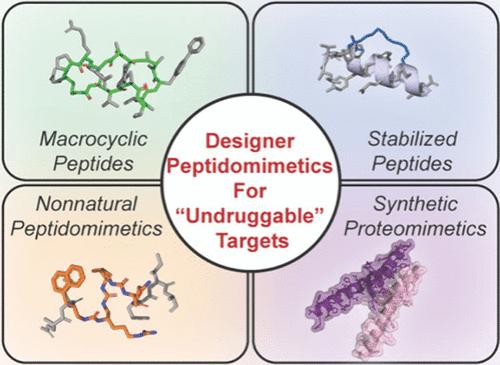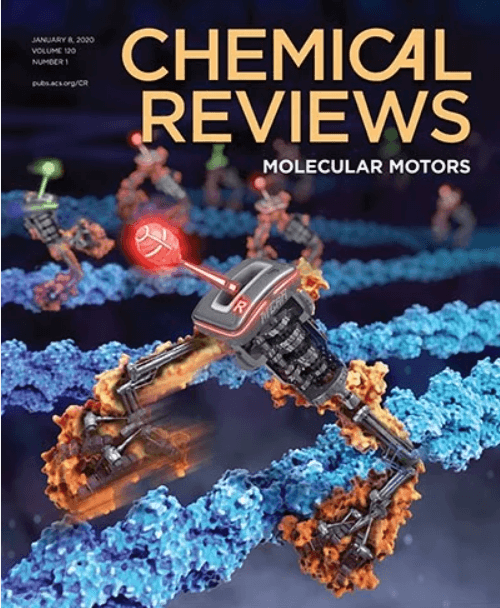Tackling Undruggable Targets with Designer Peptidomimetics and Synthetic Biologics
IF 51.4
1区 化学
Q1 CHEMISTRY, MULTIDISCIPLINARY
引用次数: 0
Abstract
The development of potent, specific, and pharmacologically viable chemical probes and therapeutics is a central focus of chemical biology and therapeutic development. However, a significant portion of predicted disease-causal proteins have proven resistant to targeting by traditional small molecule and biologic modalities. Many of these so-called “undruggable” targets feature extended, dynamic protein–protein and protein–nucleic acid interfaces that are central to their roles in normal and diseased signaling pathways. Here, we discuss the development of synthetically stabilized peptide and protein mimetics as an ever-expanding and powerful region of chemical space to tackle undruggable targets. These molecules aim to combine the synthetic tunability and pharmacologic properties typically associated with small molecules with the binding footprints, affinities and specificities of biologics. In this review, we discuss the historical and emerging platforms and approaches to design, screen, select and optimize synthetic “designer” peptidomimetics and synthetic biologics. We examine the inspiration and design of different classes of designer peptidomimetics: (i) macrocyclic peptides, (ii) side chain stabilized peptides, (iii) non-natural peptidomimetics, and (iv) synthetic proteomimetics, and notable examples of their application to challenging biomolecules. Finally, we summarize key learnings and remaining challenges for these molecules to become useful chemical probes and therapeutics for historically undruggable targets.

用设计肽拟化物和合成生物制剂攻克难以药到病除的靶点
开发强效、特异、药理上可行的化学探针和疗法是化学生物学和疗法开发的核心重点。然而,相当一部分预测的致病蛋白已被证明对传统小分子和生物方法的靶向治疗具有抗药性。这些所谓的 "不可药用 "靶点中有许多都具有扩展的、动态的蛋白质-蛋白质和蛋白质-核酸界面,这些界面是它们在正常和患病信号通路中发挥作用的核心。在这里,我们讨论了合成稳定肽和蛋白质模拟物的发展,它们是化学空间中一个不断扩大的强大区域,可用于解决不可药用靶点的问题。这些分子旨在将通常与小分子相关的合成可调性和药理特性与生物制剂的结合足迹、亲和力和特异性结合起来。在这篇综述中,我们将讨论设计、筛选、选择和优化合成 "设计者 "拟肽物和合成生物制剂的历史和新兴平台与方法。我们研究了不同类别的设计肽模拟物的灵感和设计:(i) 大环肽;(ii) 侧链稳定肽;(iii) 非天然肽模拟物;(iv) 合成蛋白质模拟物,以及将它们应用于具有挑战性的生物分子的显著实例。最后,我们总结了这些分子成为有用的化学探针和治疗剂的主要经验和仍然面临的挑战,这些探针和治疗剂可用于历史上无法药物治疗的靶点。
本文章由计算机程序翻译,如有差异,请以英文原文为准。
求助全文
约1分钟内获得全文
求助全文
来源期刊

Chemical Reviews
化学-化学综合
CiteScore
106.00
自引率
1.10%
发文量
278
审稿时长
4.3 months
期刊介绍:
Chemical Reviews is a highly regarded and highest-ranked journal covering the general topic of chemistry. Its mission is to provide comprehensive, authoritative, critical, and readable reviews of important recent research in organic, inorganic, physical, analytical, theoretical, and biological chemistry.
Since 1985, Chemical Reviews has also published periodic thematic issues that focus on a single theme or direction of emerging research.
 求助内容:
求助内容: 应助结果提醒方式:
应助结果提醒方式:


